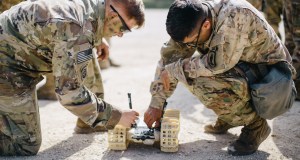Army Research Lab’s new ‘autonomy stack’ speeds up self-driving tech development

The Army Research Lab has begun using its own new “autonomy stack” to speed up the development of its autonomous vehicles program during a one-year sprint.
By owning its autonomy tech stack — all the layers of technology that support applications and development — rather than depending on a contractor for it, ARL now has more control over its Scalable, Adaptive and Resilient Autonomy (SARA) program to improve how robots drive themselves, researchers told FedScoop. Namely, it gave the lab more flexibility to assign research roles to partners to be more deliberate about what groups do and how they use the tech stack to fuse their efforts.
The SARA program kicked off its one-year sprint last year, working with eight collaborators from across the country that each was given a specific part of the complex world of autonomy to engineer new solutions to, instead of putting out broad requests for proposals.
It was “a new and different way of doing business,” Eric Spero, lead for systems engineering for autonomous robotics integration at ARL, said in an interview.
Areas of research that delivered new capabilities range from obstacle classification to navigating narrow passageways. Having the tech stack in-house allowed ARL to be more specific with the tasks it gave to researchers and reduce redundancies, Spero said.
The Army has been chasing the idea of having autonomous ground vehicles to improve the safety of soldiers in battle for years. But so far the Army has missed many of its own timelines for fielding the advanced tech. The SARA program is one of many within the department working on getting AI behind the steering wheel of its vehicles.
With a divide-and-conquer strategy in place for the lab, the eight collaborators were given specific use cases and problems to solve. When they had new code to share, they simply uploaded the software to ARL’s stack, and engineers in the Army could then use it in concert with software from other teams.
“In my mind, the biggest breakthrough is not a technology one … really the biggest innovation is programmatic,” Ethan Stump, artificial intelligence for maneuver and mobility essential research program chief scientist, told FedScoop.
The stack is completely owned by ARL. Most of it was developed in-house, and the roughly 20% that was contracted out is still wholly government-owned. That allows for the greatest amount of flexibility within ARL on how it works with research partners, Stump said.
SARA is not the very first program to utilize this new process, but so far the biggest and most successful. Leaders already have initiated a second yearlong sprint and have designs for a third.
“The strength of the SARA program is that we’re requiring the performers to work with the ARL software,” said Dr. Brett Piekarski, chief scientist of the lab’s Computational and Information Sciences Directorate.
In this case, those partners came from a more broad and diverse group than normal. University and private sector teams from across the country participated, many outside of the usual group the Army works with on autonomy problem sets, Spero said.
“With [the] SARA program, it was a little different, because instead of just putting out a call … it was more of: ‘We would like to invite you into this new collaborative environment,'” Spero said. “Folks became really innovative.”






